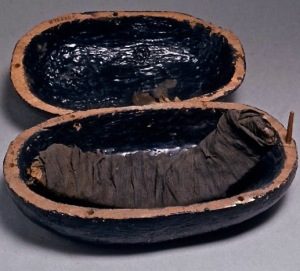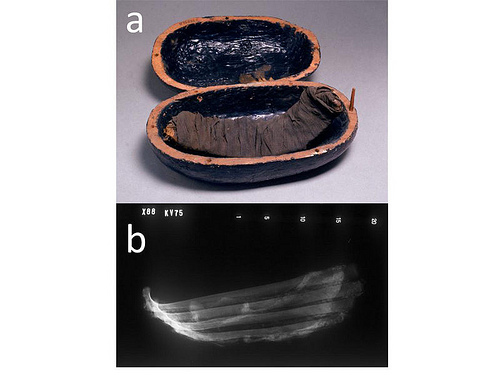
A study team consisting of researchers from the University of Bristol, UK, and the American University in Cairo, Egypt, are suggesting that some ancient Egyptian meat mummies were embalmed with organic compounds, including one meat mummy that showed evidence for the use of Pistacia resin, a highly valued luxury item.
Meat victual mummies, which are wrapped and embalmed meaty portions or joints of animals such as cattle or poultry, have typically been found within the ancient tombs of royal and high status individuals in Egypt. They are thought to have been meant as food items for consumption by the deceased in the afterlife. Such were discovered, for example, within 48 carved wooden cases in the tomb of King Tutankhamun (died c. 1323 BCE). Unlike other foods found preserved by dehydration within the tombs, however, the victual meats had to be treated in ways similar to that of the humans and animal mummies, “as untreated meat would not last more than a few hours in the Egyptian heat.”* But the exact elemental components of the substances used in the process of victual meat mummy treatment has been unclear, until now.
To investigate this, Richard Evershed and colleagues from the University of Bristol and the American University analyzed the chemical composition of tissue samples and bandages from four meat mummies – that of a calf from the tomb of Isetemkheb (c. 1064-948 BCE), a duck and goat from the tomb of Henutmehyt (c. 1290 BCE), and beef ribs from the tomb of Yuya and Tjuiu (1386-1349 BCE). They concluded that these meat mummies were prepared using a diverse range of organic compound treatments. As reported by the study group, the external bandages from a victual calf mummy contained a mixture of compounds from animal fat, but no evidence of waxes or resins. They knew this because the bandages they sampled were not in direct contact with the meat, and thus the compounds were interpreted to have been deliberately applied and not simply originating from the meat itself. Similar animal fat-derived compounds were detected with the mummified goat leg sample, but not with the mummified duck sample.
________________________________________________________________________________________________________________________
Beef rib meat mummy from the tomb of Yuya and Tjuiu (1386-1349 BC). Credit: Image courtesy of PNAS.
_______________________________________________________________________________________________________________________
The most interesting find, however, came from the analysis of the bandages associated with the mummified beef ribs (pictured above). That sample contained a mixture of fat or oil, beeswax, and Pistacia resin. Pistacia has been considered a comparatively rare luxury item in ancient Egypt.
“The date of the occurrence of Pistacia resin associated with this meat mummy predates any known association with human mummies by some 600 years,” reports Evershed, et al., “although this might change with further investigations of human mummies. The finding of Pistacia resin on this meat mummy likely relates to the status of the burial; this meat mummy was part of the funerary assemblage of the parents of Queen Tiye, wife of Amenhotep III (c. 1386–1349 BC) (34), making it among the highest status mummy balm thus far chemically analyzed in modern times.”
Conclude the researchers: “Our findings show that the sophistication of the burial extended not only to the organic balming treatments applied to the bodies themselves but also to the foods, particularly the meats, interred with them.”*
The detailed study was published in the early edition of the Proceedings of the National Academy of Sciences (PNAS) on November 18, 2013.
_______________________
Sources: Edited and adapted from a PNAS press release, excerpts from published study (see reference below).
* Article #13-15160: “Organic chemistry of balms used in the preparation of pharaonic meat mummies,” by Katherine A. Clark, Salima Ikram, and Richard P. Evershed.
Cover Photo, Top Left: Beef rib meat mummy from the tomb of Yuya and Tjuiu (1386-1349 BC). Credit: Image courtesy of PNAS.
________________________________________________________________________________________________________________________________________________
Read about the most fascinating discoveries with a premium subscription to Popular Archaeology Magazine. Find out what Popular Archaeology Magazine is all about. AND MORE:
 Popular Archaeology’s annual Discovery edition is a selection of the best stories published in Popular Archaeology Magazine in past issues, with an emphasis on some of the most significant, groundbreaking, or fascinating discoveries in the fields of archaeology and paleoanthropology and related fields. At least some of the articles have been updated or revised specifically for the Discovery edition. We can confidently say that there is no other single issue of an archaeology-related magazine, paper print or online, that contains as much major feature article content as this one. The latest issue, volume 2, has just been released. Go to the Discovery edition page for more information.
Popular Archaeology’s annual Discovery edition is a selection of the best stories published in Popular Archaeology Magazine in past issues, with an emphasis on some of the most significant, groundbreaking, or fascinating discoveries in the fields of archaeology and paleoanthropology and related fields. At least some of the articles have been updated or revised specifically for the Discovery edition. We can confidently say that there is no other single issue of an archaeology-related magazine, paper print or online, that contains as much major feature article content as this one. The latest issue, volume 2, has just been released. Go to the Discovery edition page for more information.
Subscription Price: A very affordable $5.75 for those who are not already premium subscribers of Popular Archaeology Magazine (It is FREE for premium subscribers to Popular Archaeology). Premium subscribers should email [email protected] and request the special coupon code. Or, for the e-Book version, it can be purchased for only $3.99 at Amazon.com.






